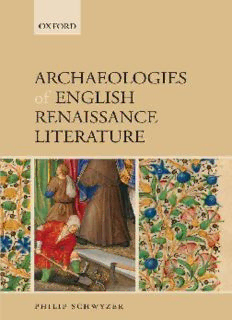
Archaeologies of English Renaissance Literature PDF
Preview Archaeologies of English Renaissance Literature
ARCHAEOLOGIES OF ENGLISH RENAISSANCE LITERATURE This page intentionally left blank Archaeologies of English Renaissance Literature PHILIP SCHWYZER 1 1 GreatClarendonStreet,Oxford OxfordUniversityPressisadepartmentoftheUniversityofOxford. ItfurtherstheUniversity’sobjectiveofexcellenceinresearch,scholarship, andeducationbypublishingworldwidein Oxford NewYork Auckland CapeTown DaresSalaam HongKong Karachi KualaLumpur Madrid Melbourne MexicoCity Nairobi NewDelhi Shanghai Taipei Toronto Withofficesin Argentina Austria Brazil Chile CzechRepublic France Greece Guatemala Hungary Italy Japan Poland Portugal Singapore SouthKorea Switzerland Thailand Turkey Ukraine Vietnam OxfordisaregisteredtrademarkofOxfordUniversityPress intheUKandincertainothercountries PublishedintheUnitedStates byOxfordUniversityPressInc.,NewYork PhilipSchwyzer2007 Themoralrightsoftheauthorhavebeenasserted DatabaserightOxfordUniversityPress(maker) Firstpublished2007 Allrightsreserved.Nopartofthispublicationmaybereproduced, storedinaretrievalsystem,ortransmitted,inanyformorbyanymeans, withoutthepriorpermissioninwritingofOxfordUniversityPress, orasexpresslypermittedbylaw,orundertermsagreedwiththeappropriate reprographicsrightsorganization.Enquiriesconcerningreproduction outsidethescopeoftheaboveshouldbesenttotheRightsDepartment, OxfordUniversityPress,attheaddressabove Youmustnotcirculatethisbookinanyotherbindingorcover andyoumustimposethesameconditiononanyacquirer BritishLibraryCataloguinginPublicationData Dataavailable LibraryofCongressCataloginginPublicationData Dataavailable TypesetbyLaserwordsPrivateLimited,Chennai,India PrintedinGreatBritain onacid-freepaperby BiddlesLtd.,King’sLynn,Norfolk ISBN978–0–19–920660–5 1 3 5 7 9 10 8 6 4 2 Formyfather, HubertSchwyzer This page intentionally left blank Preface T study would not have been possible without the assistance of a number of generous and open-minded archaeologists. I am deeply grateful to Howard Williams, Carl Knappett, and others at the Uni- versity ofExeter who responded so generously and productivelyto my venture across disciplinary divides. I have rarely been so nervous as when standing to address the research seminar of the Department of Archaeology on the subject of our disciplinary intimacy. At an earlier stage, when I was first beginning to explore the world and work of archaeology,IreceivedinvaluableguidancefromRuthTringham,Meg Conkey,DavidMiles,andBarbaraBender.Inthecourseofthisproject I have also benefited from the advice of Roberta Gilchrist, Helena Hamerow,andRichardParker. Ontheliteraryside,Iamfortunateinmymanysplendidcolleagues in the Department of English at the University of Exeter; particular thanks are owed to Pascale Aebischer, Karen Edwards, Eddie Jones, Colin McCabe, Nick McDowell, Andrew McRae, Dan North, and MinWild.IoweenduringdebtstoJeffreyKnapp,JenniferMiller,and StephenGreenblatt.Inresponsetoastringofanxiousemails,Graham Parry provided expert advice and information on many points of earlymodernantiquarianship;Ihopeheapprovesoftheoutcome.Iman Hamamshedlightonthematterofmummies,andGrantVothprovided acrucialclarifyingperspectiveontheproblemofShakespeare’stomb. Much of what follows was first presented to research seminars at Aberdeen, Bristol, Exeter, Oxford, and Sussex; I am grateful to the participantsforvaluablequestionsandsuggestionswhichhaveallowed me to make innumerable local improvements to the argument. At Oxford University Press, my editor Andrew McNeillie has been an exemplary source of support and encouragement. The anonymous readers who evaluated the manuscript offered useful advice which I hopetheywillfindreflectedinthepagesthatfollow. viii Preface Thewritingofthisbookwasmadepossiblebyayearofresearchleave, jointlyfundedbytheUniversityofExeterandtheArtsandHumanities Research Council. An abbreviated version of Chapter 3 appeared in Representations, 95 (2006). Portions of Chapter 5 have appeared as a chapter in Gerald Maclean (ed.), Reorienting the Renaissance: Cultural ExchangeswiththeEast (Palgrave,2004).Iamgratefulinbothcasesfor permissiontoreprintthoseportionshere. Mydeepestdebt,always,istoNaomiHowell,whoreadandimproved everypageoftheworkinprogressand,inthelastdaysofwriting,married me. Iwillnotspeakofthefamousbeautyofdeadwomen: Iwillsaytheshapeofaleaflayonceonyourhair. Tilltheworldendsandtheeyesareoutandthemouthsbroken Look!Itisthere! ArchibaldMacleish,‘NotMarbleNortheGildedMonuments’ Textual Note Imodernizedthespellingandpunctuationofearlymoderntexts from which I quote, with the exception of Edmund Spenser’s Faerie Queene, with its deliberately archaic diction. Quotations from Middle English texts are, where appropriate, accompanied by translations. Exceptwhereotherwisenoted,allreferencestoShakespeare’sworksare toTheNortonShakespeare, ed.StephenGreenblatt(NewYork:W.W. Norton,1997).AllreferencestoSpenser’sFaerieQueenearetoEdmund Spenser, The Faerie Queene, ed. A. C. Hamilton (London: Longman, 1977).AllquotationsfromtheBiblearefromtheKingJamesVersion, exceptwherenoted.
Description: